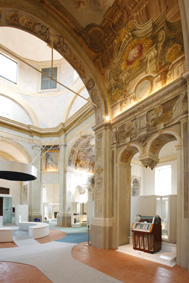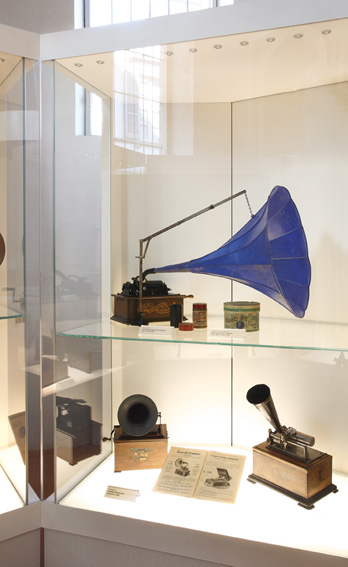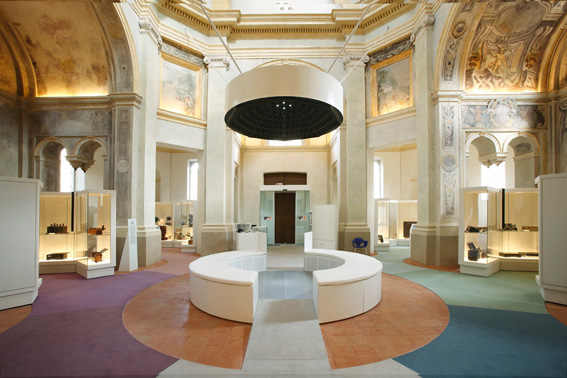Greetings from Bologna, Italy! Having completed the Carnegie Mellon portion of my dual-Master’s degree program, I am now enrolled at the  University of Bologna’s Master’s program in Innovation and Organization of Culture and the Arts (GIOCA), aka Cultural Economics. While my blog postings will not be as regular as this past year, I hope to share with our TitA followers relevant news, trends, and projects from across the Atlantic, beginning with la Casa del Suono (House of Sound), in Parma, Italy.
University of Bologna’s Master’s program in Innovation and Organization of Culture and the Arts (GIOCA), aka Cultural Economics. While my blog postings will not be as regular as this past year, I hope to share with our TitA followers relevant news, trends, and projects from across the Atlantic, beginning with la Casa del Suono (House of Sound), in Parma, Italy.
The House of Sound focuses on the technological aspects of sound. It is an avant-garde artistic and technological project dedicated to everyone who listens to music and other sounds broadcast by technological instruments. - Published in a guide by the instituto per i beni artistici culturali e naturali
Housed in a restored church and managed by the city of Parma, la Casa del Suono opened its doors to the public in December 2008. It is a project produced collaboratively by the Casa della Musica and the University of Parma. La Casa del Suono serves as an educational space with a scientific and artistic collection exhibiting the technological evolution and social implications of sound reproduction and transmission; as a research center providing instruments for innovative and futuristic developments, projects, and technologies; and as a leader in scientific and musical activity. In this way, it serves as both a museum and a laboratory.
The three best things about the museum:
1) It is a stunning, modern and bright space with incredible movement and flow. Its collection and layout are neither overwhelming nor perplexingly organized. It is rather simple, actually. There are six “niches” or round rooms (at one time, chapels). Each highlights a stage in the evolution of sound reproduction and transmission. Each niche houses about 10-14 sound reproduction and transmission devices, ranging from different countries’ first phonographs and radios to portable devices such as the compact disc and the iPod.
stage in the evolution of sound reproduction and transmission. Each niche houses about 10-14 sound reproduction and transmission devices, ranging from different countries’ first phonographs and radios to portable devices such as the compact disc and the iPod.
The niches are: (1) Reproduced Sound: From the Phonograph to the Gramophone (2) Transmitted Sound: The Birth of the Radio (3) Sound at Home: A New Household Appliance (4) Pocket Sound: From the Mobile to the Portable and (5) Sound for All: New Consumer Goods and (6) New Sound: From Analog to Digital.
2) Each niche contains an interactive touch screen from which visitors can select one of the technologies on display in the room and then a song from a set playlist of typical music from that period. The selected song is played throughout the niche, audible to visitors inside the specific niche, but not beyond.
3) The culmination of the visit is a demonstration of the research and technological advancements taking place at the Casa del Suono. Two installations, the Sonic Chandelier and the White Room, apply the theory of Wave Field Synthesis. The Sonic Chandelier uses technology that creates virtual sounds sources that move in the space above the listener. In the White Room, visitors experience the sound quality and movement of 189 speakers positioned at the same height along the perimeter of the room, creating a two-dimensional sonic field and a TRUE surround sound experience.
The Casa del Suono, aside from its architecturally supreme space, extensive collection, and cutting-edge research, asks visitors to think beyond “History of Rock 101” and the evolution of music. It has viewers reflect on sound--how people have historically received sound; how the evolution of transmitting sound and music has transformed family life, politics, and society; and how electronic technologies continue to shape access to culture, art, and science.
If you find yourself in the Emilia-Romagna region of Italy, the Casa del Suono is definitely worth a visit. It is an off-the-beaten track gem. And while you are in Parma for the day, treat yourself to a dish of the region’s pasta covered in Parma’s own parmigiano reggiano cheese. It will be a day for the books; you can trust me on that one.

